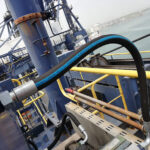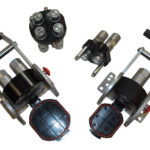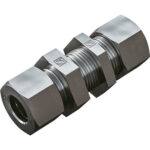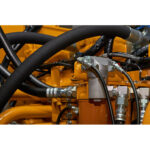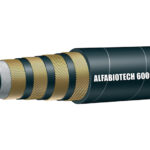As most users of fluid power technologies know, one of the most vulnerable systems for leakage is within hose assemblies. This is not because hose, fittings, and couplings are poorly designed but, most often, the result of improper assembly design and maintenance. That’s why XonKen, a Chinese manufacturer of hydraulic hose and fittings, has developed […]
Hose Assembly Blog
A primer on hydraulic hose bend radius
By Josh Cosford, Contributing Editor Hydraulic hose bend radius, quite simply, describes how tightly circular a hydraulic hose can bend. More importantly, designers and technicians wish to know the minimum bend radius a hose handles while maintaining integrity. Although one might easily force a hose into a tight radius during installation, its design and construction […]
Safety tips for connecting and disconnecting hydraulic hose
By Josh Cosford, Contributing Editor Hydraulic hoses are crucial in various fluid power industries, helping power heavy machinery and equipment by providing the very conduit through which hydraulic fluid flows. The integrity of these systems relies heavily on the proper connection and disconnection of hydraulic hoses, as mishandling hydraulic hoses can lead to severe accidents […]
How long should a hose last (and tips to extend service life)
By Josh Cosford, Contributing Editor How long a hydraulic hose should last depends on many factors, not the least of which is who you ask. Some standards want to see hoses changed every few years, yet others are okay up to ten years (such as with the SAE). But do we even need to apply […]
What are hydraulic couplers?
Hydraulic quick couplers are indispensable tools in various industries that rely on hydraulic systems. They play a crucial role in connecting and disconnecting hydraulic hoses and attachments swiftly and efficiently. These couplers provide a secure and leak-free connection, allowing for seamless fluid transfer in hydraulic systems. Typically made of durable materials like steel or brass, […]
What are metric hydraulic fittings and how do you specify them?
By Josh Cosford, Contributing Editor I vividly remember visiting my stepfather’s auto shop as a kid, where he’d worked on what was primarily American iron. Being the 80s, most vehicles were American-made, so his familiarity with imperial nuts, bolts and tools was understandable. When Japanese cars permeated the market, he was ill-prepared in both knowledge […]
What impacts hydraulic hose life?
Hydraulic hoses are critical components of any hydraulic system, and their lifespan is essential for the system’s efficiency and longevity. Several factors impact hydraulic hose life, from environmental conditions to maintenance practices. If you heed the tips below, you can enjoy long life from your hoses. One of the most critical factors impacting hydraulic hose […]
What causes hydraulic hose failure?
By Josh Cosford, Contributing Editor Hydraulic hose failures are much like vehicle collisions — they’re not accidents. No longer can you blame weather, road conditions or distractions because it’s always someone’s fault. Unless a meteorite slams into your windshield, causing you to blow through a red light, there is always a cause of collisions. The […]
Hydraulic hose routing considerations
By Josh Cosford, Contributing Editor Hydraulic hose enjoys the title of go-to fluid conveyance of choice for many hydraulic machines. Although steel tube is also popular and provides a tidy, permanent solution to plumbing, it is less easily serviced and replaced. Hydraulic hose, when properly manufactured, routed and installed, offers a tidy and permanent solution […]
Hydraulic hose tube – it’s the inside that counts
By Josh Cosford, Contributing Editor We’re all taught from a young age to place focus and worth on what’s inside, and the more thought you put into this concept, the more it rings true. For example, would an orange taste any less sweet if, on the outside, it looked like dragon fruit? And, of course, […]

